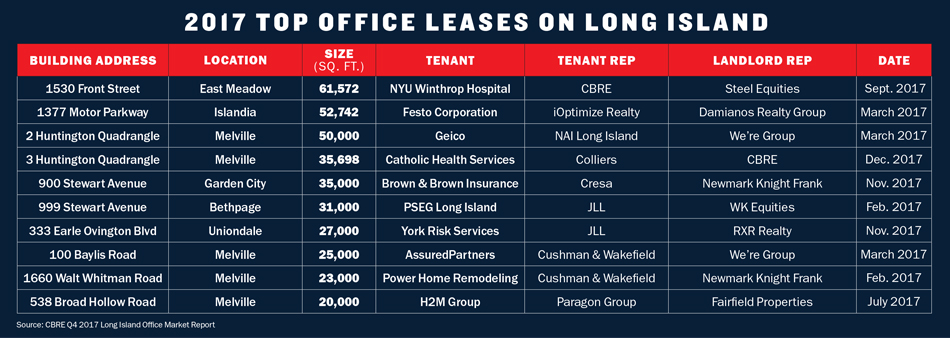Trending
Stop! Collaborate and cowork
The trend is blowing east from New York City as Long Island’s traditional offices increasingly morph into open-concept spaces

Forget the C-suite and the corner office. The operative buzzword in the Long Island office market today is “collaboration.” Companies are seeking out and building work spaces that echo the hip working environments of tech startups, where employee interaction is a prime virtue. Companies that compete for talent against businesses in Manhattan and lately, Queens, Brooklyn and even the Bronx are betting that environments that allow for maximum collaboration can attract employees, reduce space needs and increase productivity, commercial brokers said.
“Companies are cutting back on private space for individuals within offices,” said Phil Heilpern of CBRE. “It’s more open. Tenants don’t give up space they need, but they cut back where they can.”
At the same time, another version of collaboration is doing well on Long Island.
Coworking firm Regus, which has been operating on the island for the past 15 years, now has 10 locations there and is looking for more.
And out in Southampton, a new 8,000-square-foot members-only coworking space called Spur made its appearance in January and is already set to expand. “More and more people like myself are coming out [to the Hamptons] on a regular, full-time basis and they all need a place to work,” said Spur founder Ashley John Heather.
To date, coworking behemoth WeWork has not moved east beyond Long Island City to Nassau. A company spokesperson told TRD: “WeWork is always looking for new communities to expand to, but we have nothing new to announce at this time.”
Although the jury’s out on the market impact the collaboration and coworking trends will have, the overall Long Island office leasing market cooled a bit last year, with 1.8 million square feet of total space leased, down 10 percent from 2016’s activity, according to CBRE. Total absorption amounted to a positive 482,000 square feet — just half the 848,000 square feet absorbed in 2016. Average asking rents per square foot inched up 2 percent, ending the quarter at $26.77, and overall vacancies dropped to 12 percent at the end of the fourth quarter. That’s the lowest year-end rate in at least 11 years.
That’s a boon to landlords such as Rechler Equity Partners, which owns 6.5 million square feet of commercial space in Long Island — 10 percent of it office space. Last year, the firm leased out several office spaces in Hauppauge that had been empty for a couple of years. “We saw significant improvement in our office portfolio this year in terms of both occupancy and demand,” said co-managing partner Mitchell Rechler.
Not surprisingly, quality space is scarce. With little new product coming on the market and more companies able to trade up at reasonable prices, large blocks of Class A space — anything over 40,000 square feet — are hard to come by, brokers said. The result is more leverage for landlords. Instead of a year’s free rent, which had been the going offer, half a year is more the norm these days, while improvement packages have gotten stingier. What used to be a $40,000 work letter is now down to $30,000, said Heilpern. “Class A has shifted to a landlord’s market,” he said. “Concession packages are shrinking.”

At the same time, the post-recession efforts to attract millennial talent and set up shop near transit hubs are seeing some pay-off, evidenced by the declining vacancy rates. “Just out of the recession, vacancies were in the 25 percent range, and now they are closer to 10 to 12 percent, which is kind of equilibrium,” said Mike Maturo, president of RXR Realty. “Once you get inside that [range], there is a case to be made that there is some pricing power in the market.”
As for tenants, medical facilities continue to grab significant available office space. After signing the largest Long Island office lease of the year in September, NYU Winthrop Hospital gobbled up even more space in January 2018, leasing a 77,466-square-foot building with three floors of office space opposite the Mineola LIRR station. In another 2017 top-10 deal, Catholic Medical Services took nearly 36,000 square feet in Melville.
Insurance companies were the tenants in four of 2017’s top 10 leases. York Risk Services consolidated some of its operations in 27,000 square feet in Uniondale. And Geico’s lease for 50,000 square feet in Melville was the third largest of the year.
Geico’s build-out reflects the trend of creating spaces for collaboration. Large, private windowed offices for top execs are giving way to bullpens that are near windows, providing more light for nine-to- fivers. Although Geico’s new space in Melville does have private offices for top execs, those are in the interior, while the rest of the staff areas are situated next to windows, a representative of NAI said.
RXR is also outfitting several of its buildings with shared conference facilities, tenant lounges and food service areas where employees from different companies can mingle and interact — a kind of coworking environment without the coworking label. To deal with the cultural change in which some employees no longer even have assigned seats, companies are even setting up group sessions to help people accustomed to traditional working environments make the transition to collaborative spaces, said JLL’s Ray Ruiz.
“We used to call it densification — more people in less space,” said Ruiz. “Many people accustomed to working in a traditional environment are nearing retirement age, and firms have to get ahead of it.”
And while brokers don’t expect all landlords to start turning square footage into coworking spaces themselves, the industry is expanding. Regus vice president of network development Mike Berretta said business in Long Island is strong and that the company is looking for more opportunities.
“There are a few obvious holes in the map in Long Island that we want to fill,” said Berretta. “We will be looking to potentially expand as corporate demand grows.”




